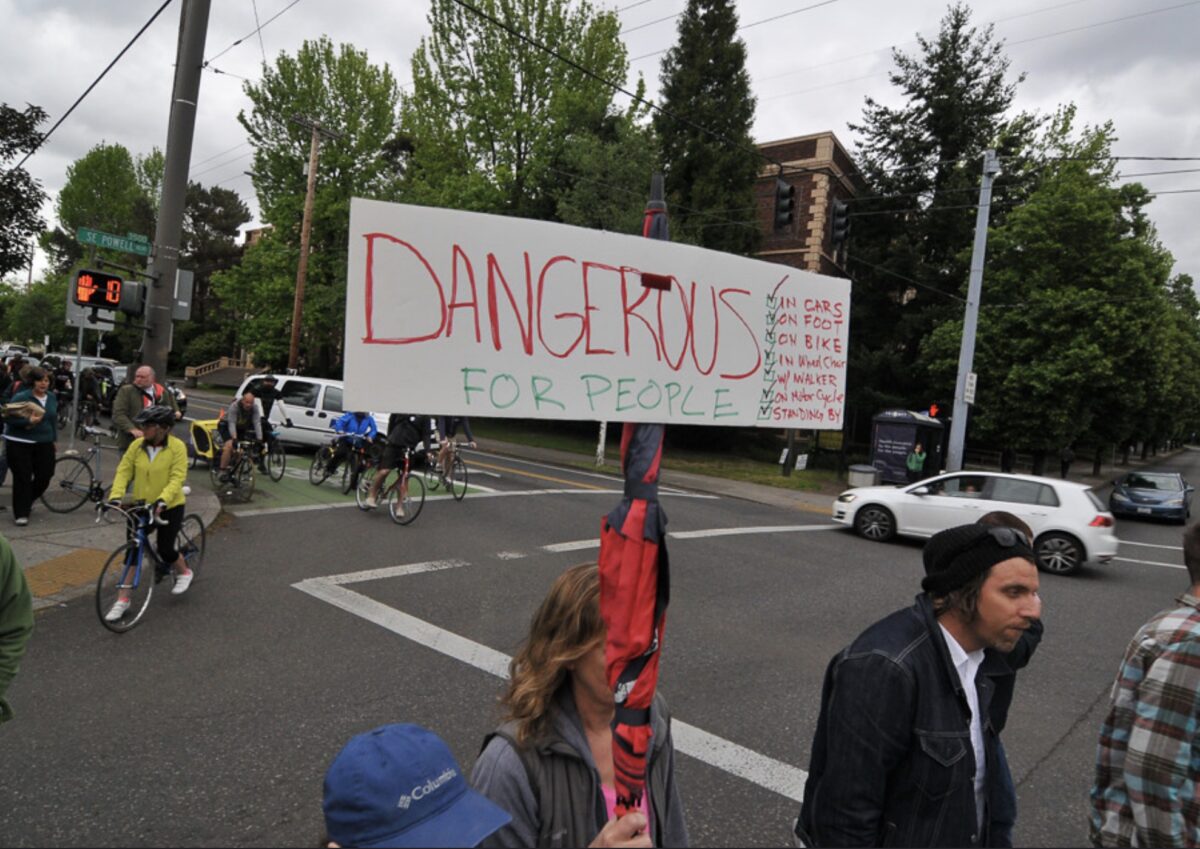
(Photo: Jonathan Maus/BikePortland)
“Technology alone will not save us. We need a national change in mentality.”
— Pete Buttigieg, U.S. DOT Secretary
Calling the mass injuries and loss of life on American roads a “national crisis”, on Thursday U.S. Department of Transportation Secretary Pete Buttigieg unveiled the National Roadway Safety Strategy (NRSS). It’s an unprecedented step from the federal government to coordinate a systemic response to the epidemic of traffic deaths and destruction.
In the lobby of DOT headquarters in Washington D.C., following an introduction by Second Gentleman Douglas Emhoff, Buttigieg said, “If you think about the fact that every one of us can think of people lost and speak of it as a sadly universal truth, it is as if we were living through war. It is as if it were normal… We cannot and must not accept that these fatalities are an inevitable part of life in America.”
For Sec. Buttigieg, the NRSS is the first step toward the goal of reaching zero roadway fatalities. He compared the upcoming new regulations and cultural shifts to how the federal government tackled food and workplace safety. “The decision to commit to [zero fatalities] in a serious way at a national level,” Buttigieg said, “Changes the way cities and towns design roads. It changes the ways companies build cars. It changes the way people drive.”

(Source: NRSS)
The NRSS itself is a 42-page plan that not only outlines the multi-layered strategy but gives us a look at national crash statistics. A map showing a state-by-state fatality rate per 100 million miles driven shows Oregon with 1.37, the highest rate on the west coast and among the top 25% deadliest in the country. The plan also centers how the lack of safety on our roads unfairly impacts people with lower-incomes, Black people and other communities of color, as well as the most vulnerable road users like bicycle riders, walkers, and transit users.
Advertisement
The plan draws a direct line between increasing deaths to walkers and bikers in the past decade to America’s effort to tackle climate change. Dangerous roads have, “… a chilling effect on
climate-friendly transportation options such as walking, biking, or taking public transportation,” it reads. And we must have safer roads, “To unlock the climate benefits of those modes.”
There are five specific categories where NRSS will focus, and each of them reveals how the DOT under Buttigieg plans to approach this massive problem:
• Safer People: Encourage safe, responsible behavior by people who use our roads and create conditions that prioritize their ability to reach their destination unharmed.
• Safer Roads: Design roadway environments to mitigate human mistakes and account for injury tolerances, to encourage safer behaviors, and to facilitate safe travel by the most vulnerable users.
• Safer Vehicles: Expand the availability of vehicle systems and features that help to prevent crashes and minimize the impact of crashes on both occupants and non-occupants.
• Safer Speeds: Promote safer speeds in all roadway environments through a combination of thoughtful, context-appropriate roadway design, targeted education and outreach campaigns, and enforcement.
• Post-Crash Care: Enhance the survivability of crashes through expedient access to emergency medical care, while creating a safe working environment for vital first responders and preventing secondary crashes through robust traffic incident management practices
In the plan, each category has a list of of “key departmental actions” to achieve it.
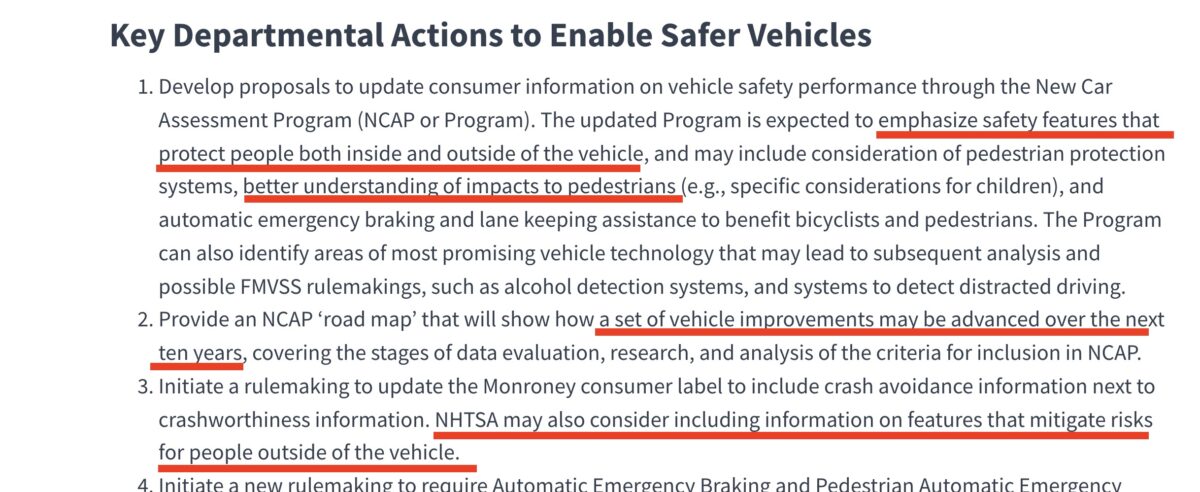
A big issue on today’s roads are obscenely large trucks and SUVs. These pose a clear and present danger because of their high grills that reduce visibility and increase the likelihood of a deadly crash. The NRSS appears to strongly address this issue (see above, emphases mine). Even one of the most prominent writers on this issue, Angie Schmitt, said on Twitter today the NRSS looks “pretty good” in how it could address this.
Advertisement
Any attempt to change the type of trucks automakers make, or the minds of their eager buyers, could turn into another culture war. Based on his comments today, Sec. Buttigieg appears ready to enlist.
“Technology alone will not save us. We need a national change in mentality,” he said Thursday. “It’s time for a transformation in how people think about roads… There’s no vaccine that will protect us from deadly car crashes today. And yet like a pandemic, it’s a case where we can only protect our loved ones by acting together through systems to change streets, laws, norms, manufacturers, technology, and drivers, all at the same time.”
Persuasive words are easy for Sec. Buttigieg. Shifting course on this issue will be hard, but this NRSS and the competence and approach of the man leading it gives us the best shot we’ve ever had. While there are plenty of quibbles to be made with the strategy (there’s no date set for the zero deaths goal and the USDOT still shows no signs of shifting the immense pots of “highway funding” into safety programs), it does feel like something substantive and different.
Oregon Walks Executive Director Ashton Simpson is one of many folks we’ve heard from today who likes what he sees. Reached on the phone for his reaction, he said, “It’s basically an expanded version of the Oregon Walks Crash Report with a more in-depth, national look.” He especially likes the detailed action items and says he thinks it could be a powerful roadmap for advocates and local agency leaders.
Will it actually trickle down to substantive change locally?
“It remains to be seen,” Simpson said. “We need our folks who are in charge at the local level and at the state level, to really take this document and use it to transform what those transportation departments look like internally. And how they approach the work… with this guidance coming from the federal level coming from the top we’re moving in the direction that we need to move in. They’re setting the tone.” For advocates like himself, he added, having the most powerful transportation leader in the country echo their sentiments and messages is a pretty big deal.


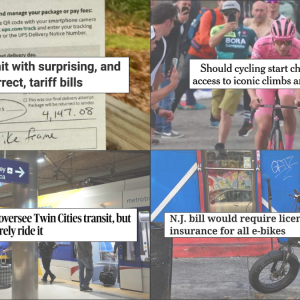
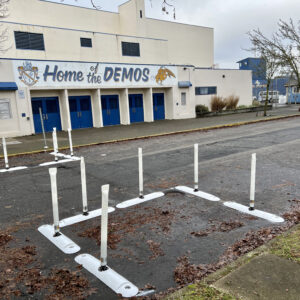
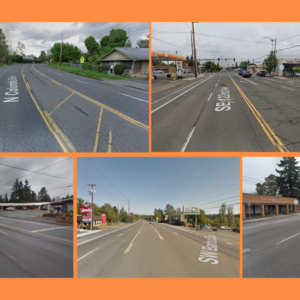
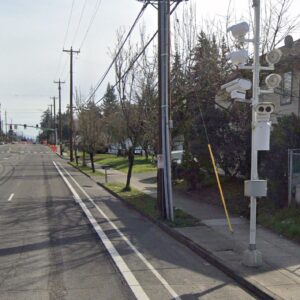
Thanks for reading.
BikePortland has served this community with independent community journalism since 2005. We rely on subscriptions from readers like you to survive. Your financial support is vital in keeping this valuable resource alive and well.
Please subscribe today to strengthen and expand our work.
The map points out Oregon’s relatively poor performance.
Oregonians are 65% more likely than Washingtonians to die on our roads, per mile travelled. We’re also more likely to die than CA, NV, ID, etc.
If safety were really ODOT’s top priorty, we might do better. (Not all these deaths are on ODOT’s roads).
(But all are on roads that could change with ODOT funding.)
(If ODOT had adequate funding, which it never has had. Oregonians hate paying taxes, and they hate even more using non-transportation funding to maintain roads.)
ODOT desperately wants to spend more than a billion dollars to make a one-mile stretch of road slightly larger.
Safety, cost, travel time, convenience, environmental impact, and other factors are all dimensions in an impossibly complex optimization problem, with different people weighing different factors differently. I agree that Oregonians seem to assign more weight to the cost dimension than I would, and undervalue the less immediate and more abstract safety dimension (and significantly undervalue the environmental dimension).
LOL. Portlanders never say no to a tax. Even very poorly written ones such as the Arts Tax, Clean Energy Fund, Free Preschool and Homeless Measure 26-210. PS Don’t you live in NC? You haven’t had to experience all the additional taxes that have come and are now coming on line in Portland/Multnomah County.
When I drive on roads in WA, they don’t seem to be engineered much different than roads in OR. I wonder if there are demographic differences that account for the disparity in deaths… For example, do Oregonians do more driving on rural highways (the most dangerous kind of facility)?
Understanding why WA is doing better might help us improve our record.
It would be interesting to see a per-capita breakout by county on traffic deaths. Urban areas obviously have more people and more cars, but as you point out rural areas are going to be more dangerous if a crash does occur.
WA has plenty of rural areas though, and Spokane is both further from the state’s large urban area and has more people (50k more) than Salem or Eugene, which makes me think there are more cars driving through rural counties than in Oregon.
It does, but if WA has a higher proportion of people living in urban areas, there per-capita statistics might appear different, even if their roads perform the same.
WA has 2.5x the population density of OR. That’s suggestive.
https://www.indexmundi.com/facts/united-states/quick-facts/compare/washington.oregon
Your suspicions are correct. Look at the statistics by state and you’ll see that there is a strong correlation between rural driving (high-speed undivided roads) and traffic deaths.
These top-down changes can’t come soon enough. If it takes 10 years to get there, that will leave us with another decade of monster truck production. Plus, automakers are making better quality vehicles now, that usually last longer. That means another few decades until the last brodozer rattles itself apart.
As for Oregon road safety, start with the easy thing we don’t have: vehicle road safety inspections and standards. I see so many burnt out brake lights and headlights, and can only imagine how bad the collective state of brakes, tire tread, and more is on our state’s private vehicles. The driver who skidded and crashed on the St. Johns Bridge had bald tires, but was only cited after he caused a fatality.
Top-down changes are needed at the state and federal level for things to truly get safer.
“Brodozer” is one of my new favorite words. EP, I’m afraid that you might be right about that timeline. Not so sure about the better quality vehicles part, though.
Great idea, except Portland just made getting pulled over for unsafe vehicle items like you note not a priority. Of course the vast majority of people here would also find safety inspections and standards regressive and likely racist, so there’s always that to look forward to. Safety is great and all, but if it disproportionately puts the responsibility on the least safe, well, we aren’t exactly into that kind of safety, we much more like the kind where you just talk about it, that stuff feels better and we can create our big truck boogey man so we don’t actually have to have the least safe drivers made more safe.
I was referring more to having safety inspections linked to vehicle registrations, and less about getting pulled over for violations and the enforcement of safety. If you had to fix the most basic things on your car to get it registered, that would be a start. It works much like our emissions tests. Having lived in a couple states with yearly safety inspections, I find it laughable (and tragic) that we don’t do anything. You could fred flinstone into the DEQ with your feet through the floor, and as long as the emissions pass, you’re good to go!
But, as we can currently see citywide, no one’s bothering to register or insure vehicles, so passing safety inspections would be even further down the list. Still, if we removed all these violating vehicles, and people without licenses or insurance, from the roads, they would likely be much safer.
Doing something about those high grills that have become common on SUVs and trucks will be welcome. When BikePortland subscriber Charles McCarthy was hit in a crosswalk by the elevated grill of a left-turning truck the impact was not high speed, but it occurred in his torso, and his heart failed shortly after arriving at the hospital:
https://bikeportland.org/2018/12/06/a-tragic-realization-about-a-bikeportland-reader-and-supporter-292892
$1,000 tax per square foot of vehicle frontal area would add about $15k to the cost of these large trucks.
Under that scheme, the cheapest vehicles would be ones with knife-like blades in front, which probably wouldn’t be any safer.
I admire him, like the plan but have 0 hope of actual change. The pushback on this will be huge, DOT’s that don’t want to get on board (probably most of them) will know they just have to wait for an administration change for business as usual to come back.
Yes, I’ve given up. I’m accepting a far lower standard of living right now than our (my partner and I) incomes allow in order to be able to retire out of the country as soon as possible.
I’d rather have less disposable income in a country where they have already achieved the vastly lower violent crime, road violence and police violence numbers that we can only dream of.
This plan is a nothing more than a cheap performance from a cynical corporate american. In ~9 months the republicans will control the purse strings and will enthusiastically block attempts to regulate the right of USAnians to kill pedestrians with ever more monstrous TRUCKS/SUVs/(cars).
Should we have less big vehicles on the roads, sure. But to blame the vehicle over the driver seems odd. I feel the responsibility for safe driving rests with the driver, not the inanimate object they are using.
For me, on my walk this morning to the coffee shop, the person that was driving the big SUV Cadilac looked both ways and saw me and stopped. The person driving the Prius was only focused on whether traffic was coming towards them as they were pulling out and didn’t bother looking my way.
Somehow people need to quit thinking of only themselves. Unfortunately, in our Facebook, Twitter, Instagram society it seems to be a lost cause.
Yes…I am a pretty good candidate for ‘anecdotal expert’. I ride recreationally about 200 miles a week on the rural roads of Deschutes County and I walk about 25 miles a week on the streets of the City of Bend. I see no difference in the behavior of different types of drivers. Well, except Prius don’t ‘roll coal’, but, in terms of their aggression and risk toward me, no discernable difference. Yes, big trucks have a harder time seeing me, and me seeing the driver, due to their height.
…says the guy who’s never been “volt rolled” by a low-rider Prius. It’s a shocking experience.
Volt Rolling sounds like how you become The Flash!
Good road and urban design practices should take into account people who AREN’T responsible, or certain situations where typically responsible people make mistakes. That’s where accidents happen. The point IMHO is not to blame anyone but to have infrastrtucture that is safer for everyone, even in outlier situations.
I think the argument about bigger vehicles (with a higher profile) is more about the increased risk of death to the pedestrian it hits compared to a lower vehicle.
Cool coffee walk story, bro.
Question: A vehicle doing errands around town runs a stop sign and hits you/your family/a car full of kittens & nuns. What kind of vehicle do you want to be hit by? A smaller one, designed around practical safety standards for pedestrians and vulnerable road users? OR, some giant, pointless, PERSONAL FREEDOM EDITION, Cadillac Escalade/quad cab diesel/some other useless, giant, inefficient thing?
Our roads should be filled with smaller, reasonable sized vehicles that won’t kill everyone. Instead we’ve got an arms race with people driving vehicles with capabilities and capacities they have no need for. Oh yeah, they all come with giant TV screens and the drivers are ever-more distracted. What’s the worst that could happen?!
Oregon has worse traffic safety statistics then Texas.
That is a real indictment on Governor Kate Brown’s leadership at ODOT. She turned freeway planning into a political hot potato. Instead of logical network based transport planners. Her, Sen. Lee Beyers and Sen. Steiner- Warner (second lady to PBOT and first lady to Oregon’s budget process and therefore ODOT outlays) have turned the OTC into a long term sh1tshow of demo might. She could have turned this into a public health impact big win. Instead she cow-towed to the good old boys.
We can see the numbers KB you ducked over ODOT and Oregonians, and more are dead because of your direct terrible management at ODOT. Fire Strickland and maybe we can make good over this.
I think you’re conflating Rep. Barbara Smith Warner, with Sen. Elizabeth Steiner Hayward, yes? But, your point stands!
Yep confusing, referring to Smith-Warner here.
Oregon isn’t the worst by far. All 10 of the worst are in the Bible Belt with S. Carolina being the worst of the worst. Google it.
I don’t see Roberta saying Oregon is the worst, just that it is worse than Texas.
Our new motto: Oregon — Not dead last.
You should also look at city and county transportation departments as well. Too many deaths are on facilities not operated by ODOT. It’s an all-inclusive problem in Oregon.
It needs to include neighborhood infrastructure if it is going to help. In Portland the improvements we’ve made for safety on the arterials has pushed bad drivers into neighborhood streets that are missing sidewalks, pavement, and calming devices like roundabouts, diversions, and speed bumps. This is more of an issue in the areas where people have lower incomes. I know for where I live we can’t appreciate the recent improvements to nearby streets because for our street it made a bad situation worse.
This would be wonderful if it weren’t doomed to be discarded when this administration is tossed out for all of their other failures. In fact, tying road safety to “climate change” dooms this initiative alone IMHO.
It’s time to start holding “progressives” accountable for their results and not just their lofty plans. By that standard we should all be deeply wary when they announce a new initiative. Everything they turn their attention to GETS WORSE.
The transportation secretary is firmly in the center/center right. It’s time to start holding centrist “market” fundamentalists accountable for the horrific consequences of their narcissism and greed.
(Not holding my breath.)
Unfortunately, this kind of thing is not uncommon among the so-called cycling community.
So you’re going with the “no true scotsman” excuse?
This is why “progressives” are never actually your friend people. They’ll cut you out of their purity circle as readily as Soren throws Pete Buttigieg overboard. Nothing personal, you’re just evil now. Sorry, not sorry!
Incidentally, I don’t know what happened to my previous comment here. Since I sometimes say things that progressives find “shocking”, I’ve been put on a permanent moderation list and sometimes my comments disappear.
I’m no fan of centrists or progressives (different facets neoliberalism) but I am a supporter of Scottish independence.
• Post-Crash Care…
Michigan formerly offered lifetime care to survivors of motor vehicle crashes who were disabled or needed therapy beyond the emergency room. The state legislature recently killed the insurance surcharge that paid for it, the trust fund is exhausted, and traffic violence victims are–back on the street?
Michigan went from being a national leader to one of the worst in compensation of crash victims. People who have car insurance can easily get coverage for immediate expenses but the lifetime cost of a crash isn’t easily predictable so compensation is not assured even with a settled lawsuit.
One way to make an immediate impact in Portland would be to re-introduce ENFORCEMENT of our traffic laws. Right now drivers know they can do anything they want with no consequences.
I noticed that almost immediately after the mayor announced that traffic enforcement was on hold in the early days of COVID folks in my own neighborhood started going “wild.”
I see behaviour now that I never saw pre-Covid. Vehicles easily going 25-30 mph above the speed limit on a routine basis, and stop signs, yeah, what are those?!?!